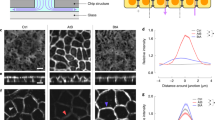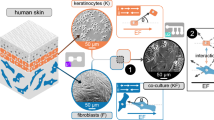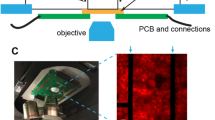Abstract
It has long been known that cells can be induced to migrate by the application of small d.c. electric fields (EFs), a phenomenon referred to as galvanotaxis. We recently reported some significant effects of electric signals of physiological strength in guiding cell migration and wound healing. We present here protocols to apply an EF to cells or tissues cultured in an electrotactic chamber. The chamber can be built to allow controlled medium flow to prevent the potential development of chemical gradients generated by the EFs. It can accommodate cells on planar culture or tissues in 3D gels. Mounted on an inverted microscope, this setup allows close and well-controlled observation of cellular responses to electric signals. As similar EFs are widely present during development and wound healing, this experimental system can be used to simulate and study cellular and molecular responses to electric signals in these events.
This is a preview of subscription content, access via your institution
Access options
Subscribe to this journal
Receive 12 print issues and online access
$259.00 per year
only $21.58 per issue
Buy this article
- Purchase on Springer Link
- Instant access to full article PDF
Prices may be subject to local taxes which are calculated during checkout









Similar content being viewed by others
References
DuBois-Reymond, E. Vorläufiger Abriss einer Untersuchung uber den sogenannten Froschstrom und die electomotorischen Fische. Ann. Phy. U. Chem. 58, 1–30 (1843).
Chiang, M.C., Cragoe, E.J. Jr. & Vanable, J.W. Jr. Intrinsic electric fields promote epithelization of wounds in the newt, Notophthalmus viridescens . Dev. Biol. 146, 377–385 (1991).
Barker, A.T., Jaffe, L.F. & Vanable, J.W. Jr. The glabrous epidermis of cavies contains a powerful battery. Am. J. Physiol. 242, R358–R366 (1982).
Borgens, R.B., Vanable, J.W. Jr. & Jaffe, L.F. Bioelectricity and regeneration: large currents leave the stumps of regenerating newt limbs. Proc. Natl. Acad. Sci. USA 74, 4528–4532 (1977).
Jaffe, L.F. & Vanable, J.W. Jr. Electric fields and wound healing. Clin. Dermatol. 2, 34–44 (1984).
Reid, B., Song, B., McCaig, C.D. & Zhao, M. Wound healing in rat cornea: the role of electric currents. FASEB J. 19, 379–386 (2005).
Chiang, M., Robinson, K.R. & Vanable, J.W. Jr. Electrical fields in the vicinity of epithelial wounds in the isolated bovine eye. Exp. Eye Res. 54, 999–1003 (1992).
Kloth, L.C. Electrical stimulation for wound healing: a review of evidence from in vitro studies, animal experiments, and clinical trials. Int. J. Low Extrem. Wounds 4, 23–44 (2005).
Nuccitelli, R. Endogenous electric fields in embryos during development, regeneration and wound healing. Radiat. Prot. Dosimetry 106, 375–383 (2003).
Nuccitelli, R. A role for endogenous electric fields in wound healing. Curr. Top. Dev. Biol. 58, 1–26 (2003).
Robinson, K.R. & Messerli, M.A. Left/right, up/down: the role of endogenous electrical fields as directional signals in development, repair and invasion. Bioessays 25, 759–766 (2003).
Sta Iglesia, D.D., Cragoe, E.J. Jr. & Vanable, J.W. Jr. Electric field strength and epithelization in the newt (Notophthalmus viridescens). J. Exp. Zool. 274, 56–62 (1996).
Sta Iglesia, D.D. & Vanable, J.W. Jr. Endogenous lateral electric fields around bovine corneal lesions are necessary for and can enhance normal rates of wound healing. Wound Repair Regen. 6, 531–542 (1998).
McCaig, C.D., Rajnicek, A.M., Song, B. & Zhao, M. Controlling cell behavior electrically: current views and future potential. Physiol. Rev. 85, 943–978 (2005).
Foulds, I.S. & Barker, A.T. Human skin battery potentials and their possible role in wound healing. Br. J. Dermatol. 109, 515–522 (1983).
Hotary, K.B. & Robinson, K.R. Endogenous electrical currents and voltage gradients in Xenopus embryos and the consequences of their disruption. Dev. Biol. 166, 789–800 (1994).
Jaffe, L.F. & Stern, C.D. Strong electrical currents leave the primitive streak of chick embryos. Science 206, 569–571 (1979).
Shi, R. & Borgens, R.B. Embryonic neuroepithelial sodium transport, the resulting physiological potential, and cranial development. Dev. Biol. 165, 105–116 (1994).
Shi, R. & Borgens, R.B. Three-dimensional gradients of voltage during development of the nervous system as invisible coordinates for the establishment of embryonic pattern. Dev. Dyn. 202, 101–114 (1995).
Levin, M., Thorlin, T., Robinson, K.R., Nogi, T. & Mercola, M. Asymmetries in H+/K+-ATPase and cell membrane potentials comprise a very early step in left-right patterning. Cell 111, 77–89 (2002).
Hotary, K.B. & Robinson, K.R. Evidence of a role for endogenous electrical fields in chick embryo development. Development 114, 985–996 (1992).
Borgens, R.B., Jaffe, L.F. & Cohen, M.J. Large and persistent electrical currents enter the transected lamprey spinal cord. Proc. Natl. Acad. Sci. USA 77, 1209–1213 (1980).
Borgens, R.B., Roederer, E. & Cohen, M.J. Enhanced spinal cord regeneration in lamprey by applied electric fields. Science 213, 611–617 (1981).
Borgens, R.B., Blight, A.R. & McGinnis, M.E. Behavioral recovery induced by applied electric fields after spinal cord hemisection in guinea pig. Science 238, 366–369 (1987).
Shapiro, S. et al. Oscillating field stimulation for complete spinal cord injury in humans: a phase 1 trial. J. Neurosurg. Spine 2, 3–10 (2005).
McCaig, C.D. & Zhao, M. Physiological electrical fields modify cell behaviour. Bioessays 19, 819–826 (1997).
Mycielska, M.E. & Djamgoz, M.B. Cellular mechanisms of direct-current electric field effects: galvanotaxis and metastatic disease. J. Cell Sci. 117, 1631–1639 (2004).
Erickson, C.A. & Nuccitelli, R. Embryonic fibroblast motility and orientation can be influenced by physiological electric fields. J. Cell Biol. 98, 296–307 (1984).
Hinkle, L., McCaig, C.D. & Robinson, K.R. The direction of growth of differentiating neurones and myoblasts from frog embryos in an applied electric field. J. Physiol. 314, 121–135 (1981).
McCaig, C.D., Rajnicek, A.M., Song, B. & Zhao, M. Has electrical growth cone guidance found its potential? Trends Neurosci. 25, 354–359 (2002).
Nishimura, K.Y., Isseroff, R.R. & Nuccitelli, R. Human keratinocytes migrate to the negative pole in direct current electric fields comparable to those measured in mammalian wounds. J. Cell Sci. 109, 199–207 (1996).
Pullar, C.E. et al. β4 Integrin and EGF coordinately regulate electric field-mediated directional migration via Rac1. Mol. Biol. Cell 17, 4925–4935 (2006).
Song, B., Zhao, M., Forrester, J.V. & McCaig, C.D. Electrical cues regulate the orientation and frequency of cell division and the rate of wound healing in vivo . Proc. Natl. Acad. Sci. USA 99, 13577–13582 (2002).
Zhao, M., Forrester, J.V. & McCaig, C.D. A small, physiological electric field orients cell division. Proc. Natl. Acad. Sci. USA 96, 4942–4946 (1999).
Zhao, M. et al. Electrical signals control wound healing through phosphatidylinositol-3-OH kinase-gamma and PTEN. Nature 442, 457–460 (2006).
Vanhaesebroeck, B. Charging the batteries to heal wounds through PI3K. Nat. Chem. Biol. 2, 453–455 (2006).
Borgens, R.B., Shi, R., Mohr, T.J. & Jaeger, C.B. Mammalian cortical astrocytes align themselves in a physiological voltage gradient. Exp. Neurol. 128, 41–49 (1994).
Cho, M.R., Thatte, H.S., Lee, R.C. & Golan, D.E. Induced redistribution of cell surface receptors by alternating current electric fields. FASEB J. 8, 771–776 (1994).
Cooper, M.S. & Keller, R.E. Perpendicular orientation and directional migration of amphibian neural crest cells in dc electrical fields. Proc. Natl. Acad. Sci. USA 81, 160–164 (1984).
Jaffe, L.F. Electrophoresis along cell membranes. Nature 265, 600–602 (1977).
Patel, N. & Poo, M.M. Orientation of neurite growth by extracellular electric fields. J. Neurosci. 2, 483–496 (1982).
Poo, M.M. & Robinson, K.R. Electrophoresis of concanavalin A receptors along embryonic muscle cell membrane. Nature 265, 602–605 (1977).
Poo, M.M., Poo, W.J. & Lam, J.W. Lateral electrophoresis and diffusion of concanavalin A receptors in the membrane of embryonic muscle cell. J. Cell Biol. 76, 483–501 (1978).
Zhao, M., Agius-Fernandez, A., Forrester, J.V. & McCaig, C.D. Orientation and directed migration of cultured corneal epithelial cells in small electric fields are serum dependent. J. Cell Sci. 109 (Pt 6): 1405–1414 (1996).
Robinson, K.R. Endogenous and applied electrical currents: their measurement and application. in Electric Fields in Vertebrate Repair (ed. Alan R. Liss) 1–25 (John Wiley & Sons, 1989).
Zhao, M., Jin, T., McCaig, C.D., Forrester, J.V. & Devreotes, P.N. Genetic analysis of the role of G protein-coupled receptor signaling in electrotaxis. J. Cell Biol. 157, 921–927 (2002).
Eagle, H. Buffer combinations for mammalian cell culture. Science 174, 500–503 (1971).
Jenkins, L.S., Duerstock, B.S. & Borgens, R.B. Reduction of the current of injury leaving the amputation inhibits limb regeneration in the red spotted newt. Dev. Biol. 178, 251–262 (1996).
Adams, D. & Levin, M. Strategies and techniques for investigation of biophysical signals in patterning. in Analysis of Growth Factor Signaling in Embryos (eds. Whitman, M. & Sater, A.K.) 177–214 (Methods in Signal Transduction Series, CRC Press, 2006).
Acknowledgements
This work was supported by the Wellcome Trust, UK. We thank Dr. Vic Small, Institute of Molecular Biotechnology of the Austrian Academy of Sciences, Vienna, for reading and commenting on the manuscript.
Author information
Authors and Affiliations
Corresponding authors
Ethics declarations
Competing interests
The authors declare no competing financial interests.
Rights and permissions
About this article
Cite this article
Song, B., Gu, Y., Pu, J. et al. Application of direct current electric fields to cells and tissues in vitro and modulation of wound electric field in vivo. Nat Protoc 2, 1479–1489 (2007). https://doi.org/10.1038/nprot.2007.205
Published:
Issue Date:
DOI: https://doi.org/10.1038/nprot.2007.205
This article is cited by
-
Direct coupled electrical stimulation towards improved osteogenic differentiation of human mesenchymal stem/stromal cells: a comparative study of different protocols
Scientific Reports (2024)
-
Snowflake-inspired and blink-driven flexible piezoelectric contact lenses for effective corneal injury repair
Nature Communications (2023)
-
Electrotaxis evokes directional separation of co-cultured keratinocytes and fibroblasts
Scientific Reports (2023)
-
Electrically stimulated Acetobacter xylinum for the production of aligned 3D microstructured bacterial cellulose
Cellulose (2023)
-
Electrical stimulation-based conductive hydrogel for immunoregulation, neuroregeneration and rapid angiogenesis in diabetic wound repair
Science China Materials (2023)
Comments
By submitting a comment you agree to abide by our Terms and Community Guidelines. If you find something abusive or that does not comply with our terms or guidelines please flag it as inappropriate.



